
Wetenschap
Verborgen microbioom versterkt dieren, ook planten
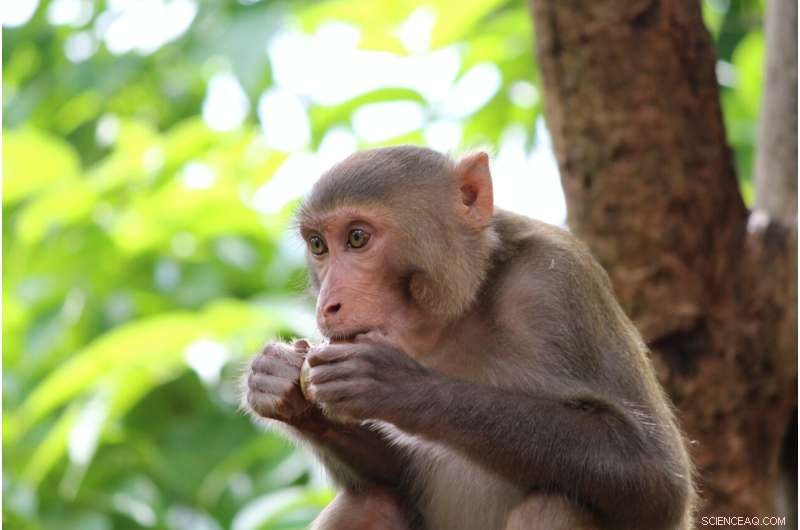
Tegoed:Unsplash/CC0 Publiek domein
Het microbioom is de verzameling microben die een habitat, het menselijk lichaam of anderszins, koloniseren. Dankzij baanbrekend microbioomonderzoek aan de Washington University School of Medicine in St. Louis, begrijpen mensen over de hele wereld nu veel meer over de fundamentele rol van darmmicroben bij de menselijke gezondheid en ziekte.
Dieren en planten vertrouwen ook op duizenden verschillende microben om ze in leven te houden. Hoewel er minder bekend is over deze associaties, onderzoekt een nieuwe generatie wetenschappers de relaties tussen een verborgen leger van microben en de wezens die ze ondersteunen en versterken. Deze microben van diverse ecosystemen (mDivE-STL) staan centraal tijdens een onderzoekssymposium op 3 oktober, georganiseerd door het Living Earth Collaborative.
Bij verschillende onderzoeksinstellingen in St. Louis bestuderen onderzoekers zowel menselijke als niet-menselijke microbiomen. Dit symposium werd georganiseerd om een gemeenschap van onderzoekers te helpen ontwikkelen die diverse microbiële systemen bestuderen en tegelijkertijd profiteren van de grote lokale kracht in de expertise van het menselijk microbioom.
Neem bijvoorbeeld onderzoekers die zwarte brulapen (Alouatta pigra) in Noord- en Midden-Amerika bestuderen. Deze grote, charismatische apen staan bekend om het maken van een van de luidste geluiden in de tropische wouden van Mexico, Guatemala en Belize.
Als in bomen levende herbivoren consumeren zwarte brulapen voornamelijk boom- en wijnbladeren, bloemen en fruit. Omdat ze geen enzymen hebben die cellulose kunnen verteren - het koolhydraat waaruit de bladcelwand bestaat - vertrouwen zwarte brulapen op fermentatie die wordt geactiveerd door hun darmmicrobiota om de energie die ze nodig hebben uit dit voedsel te halen.
Dat hele proces kan veel dynamischer zijn dan eerder werd gerealiseerd, blijkt uit onderzoek van wetenschappers van de Washington University. Er beginnen aanwijzingen te komen dat voedingsgerelateerde microbiële veranderingen in de darm de energie en de beschikbaarheid van voedingsstoffen bufferen voor dieren zoals zwarte brulapen.
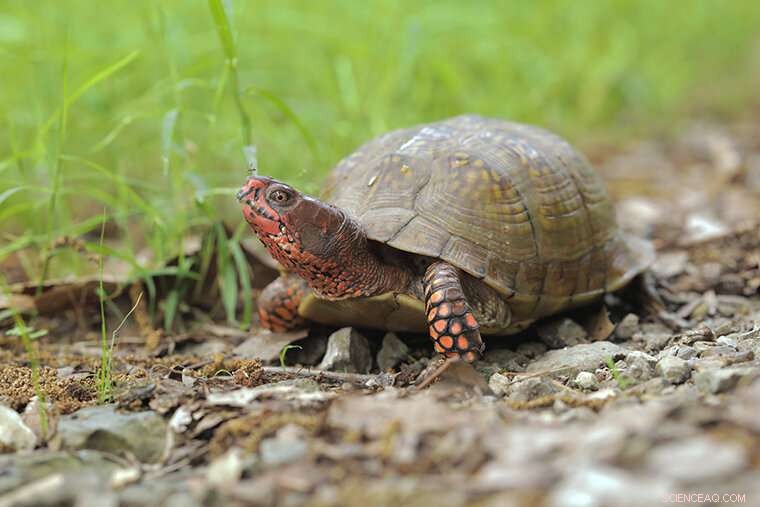
Een wilde doosschildpad in het Tyson Research Center, het milieustation van de Universiteit van Washington. Met steun van het Living Earth Collaborative hebben onderzoekers het St. Louis Box Turtle Project uitgebreid om de inheemse microbiomen van drietenige doosschildpadden te karakteriseren. Krediet:Thomas Malkowicz / Washington University
Elizabeth Mallott, een assistent-professor biologie in Arts &Sciences, gebruikt metabolomics om te onderzoeken hoe microbiële metabolismes reageren op veranderingen in wat en hoeveel hun gastheren eten. Ze voerde onlangs een onderzoek uit met een populatie wilde zwarte brulapen die jaarlijks drie verschillende seizoenen meemaken die hun dieet beïnvloeden:een nat, door fruit gedomineerd seizoen; een droog, door bladeren gedomineerd seizoen; en een droog, door fruit gedomineerd seizoen.
"We kunnen zien dat wanneer de apen meer van een specifieke voedingsstof eten, de darmmicroben die voedingsstof meer metaboliseren", zegt Mallott, eerste auteur van het onderzoek gepubliceerd in Molecular Ecology . "But beyond that, what was exciting is that we could look at the interactions between the microbes and the metabolites in different seasons, including seasons where the monkeys were limited nutritionally or energetically by the food that was available in their environment."
Microbes tend to compensate during lean times, Mallott discovered, prioritizing functions that provide more nutrients to the host. But that system falls apart when food availability becomes truly limited.
"Then the microbes seem to be scrambling. They just try to steal as many nutrients from each other as possible," said Mallott, who also looks at how environmental variation impacts the gut microbiome in humans.
Microbes could benefit species conservation
Studying the microbiomes of animal populations that thrive in the wild is important because it may provide researchers with candidate microbes and microbial consortia that could be used to improve disease resistance, nutrient absorption and ultimately the fitness of threatened species or animals that reside in degraded habitats.
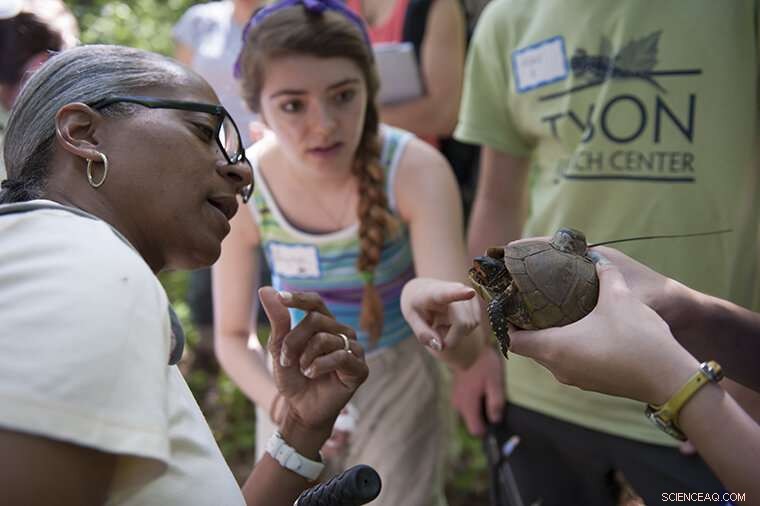
Visitors take a close look at “Parkey,” a turtle tagged and tracked as part of the St. Louis Box Turtle Project. With support from the Living Earth Collaborative, researchers have expanded the project to characterize the native microbiomes of three-toed box turtles. Credit:Sid Hastings / Washington University
This is true for mammals including black howler monkeys, but also reptiles such as the Missouri native box turtles—including the ones that the Saint Louis Zoo Institute for Conservation Medicine has studied at two sites in the St. Louis area since 2012, as part of the St. Louis Box Turtle Project.
With support from the Living Earth Collaborative, researchers are expanding that effort to include characterizing the microbiomes of three-toed box turtles and exploring how they vary within and between populations. Scientists from the laboratory of Fangqiong Ling, an assistant professor of energy, environmental and chemical engineering at the McKelvey School of Engineering, are collaborating on this turtle project to integrate microorganisms into the wildlife conservation toolbox.
"In general, wildlife microbiomes—the bacteria, archaea, protists and viruses that are found inside and on the body—are an understudied aspect of biodiversity conservation," said Sharon L. Deem, director of the Institute for Conservation Medicine and of the Saint Louis Zoo WildCare Institute Center for Chelonian Conservation.
Deem and Mallott are both scheduled to speak at the Oct. 3 research symposium, which was organized by Ling, Gautam Dantas, a professor of pathology and immunology at the School of Medicine, and Jonathan Losos, the William H. Danforth Distinguished University Professor of biology in Arts &Sciences and director of the Living Earth Collaborative.
About half of the microbiome research that will be presented relates to animals, plants and the environment, while the rest is more closely related to human health.
"You can't really understand the human microbiome and its interesting dynamics if you don't consider it in the context of the environment," said Dantas, who describes the microbiome research in his laboratory as being about 90% focused on humans and 10% in other habitats, including plants, soil and the built environment. "Even if you're purely focused on the microbes in humans, you're not going to be able to explain the important dynamics of those of that ecosystem if you don't understand the interactions in microbes within and on the body, and where those microbes come from." + Verder verkennen
Humans evolved with their microbiomes. Like genes, your gut microbes pass from one generation to the next
 Beschermend coatingmateriaal herstelt zichzelf in 30 minuten bij blootstelling aan zonlicht
Beschermend coatingmateriaal herstelt zichzelf in 30 minuten bij blootstelling aan zonlicht Het bepalen van de verslanking van houtpulp
Het bepalen van de verslanking van houtpulp De volgende generatie draagbare apparaten blijven langer opgeladen en volgen bewegingen beter
De volgende generatie draagbare apparaten blijven langer opgeladen en volgen bewegingen beter Hoe is isopropylalcohol gemaakt?
Hoe is isopropylalcohol gemaakt?  De effecten van waterpolariteit op levende wezens
De effecten van waterpolariteit op levende wezens
 Welke dieren eten Chipmunks?
Welke dieren eten Chipmunks?  Wasmiddelmoleculen kunnen fluctuaties in atmosferische methaanconcentraties veroorzaken
Wasmiddelmoleculen kunnen fluctuaties in atmosferische methaanconcentraties veroorzaken Onderzoek onthult ongelijkheden in koolstofvoetafdruk van Chinese huishoudens
Onderzoek onthult ongelijkheden in koolstofvoetafdruk van Chinese huishoudens Griekenland vraagt EU om luchtsteun om branden te bestrijden
Griekenland vraagt EU om luchtsteun om branden te bestrijden NIST zoektocht naar klimaatvriendelijke koelmiddelen levert ingewikkelde keuzes op
NIST zoektocht naar klimaatvriendelijke koelmiddelen levert ingewikkelde keuzes op
Hoofdlijnen
- Wat is het diploïde nummer?
- De zeeschildpad die weigerde te worden geslagen door de storm
- Hoe maak je een 3-D DNA-model voor High School Biology
- Science Fair-projecten met nagellak
- Je gebruikt heuristieken al elke dag. Dit is wat ze zijn
- Lymphatic System Science Activities
- Onderzoekers ontdekken dat de celcortex wordt geactiveerd door duizenden kortlevende eiwitcondensaten
- Hoe genoctrooien werken
- Taxonomie (biologie): definitie, classificatie en voorbeelden
- Wetenschappers ontdekken een genetisch mechanisme dat het opbrengstpotentieel van graangewassen zou kunnen verbeteren
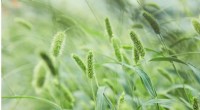
- RIP Jeremy de lefty tuinslak
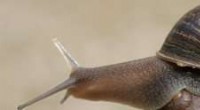
- Een afweermechanisme om darmwormen te doden
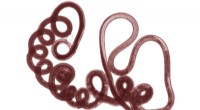
- Meld-en-klauwzeer:de lacunes in de inspanningen van Zuid-Afrika om het onder controle te houden
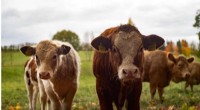
- Waarom kunnen we ons niet herinneren dat we baby's waren?

 Staat de Brunt-ijsplaat op de rand?
Staat de Brunt-ijsplaat op de rand? Peter Brian Medawar
Peter Brian Medawar  Kerkuilen blijken geen gehoorverlies te hebben naarmate ze ouder worden
Kerkuilen blijken geen gehoorverlies te hebben naarmate ze ouder worden Hoe te weten wanneer een titratie voltooid is
Hoe te weten wanneer een titratie voltooid is Zuurgraad van functionele groepen
Zuurgraad van functionele groepen Ultradunne halfgeleiders zijn voor het eerst elektrisch verbonden met supergeleiders
Ultradunne halfgeleiders zijn voor het eerst elektrisch verbonden met supergeleiders S.Africa-tieners bouwen zonnetrein terwijl stroomuitval forenzen achtervolgt
S.Africa-tieners bouwen zonnetrein terwijl stroomuitval forenzen achtervolgt Mobiele telefoons helpen rampenbestrijding te transformeren
Mobiele telefoons helpen rampenbestrijding te transformeren
- Elektronica
- Biologie
- Zonsverduistering
- Wiskunde
- French | Italian | Spanish | Portuguese | Swedish | German | Dutch | Danish | Norway |

-
Wetenschap © https://nl.scienceaq.com

